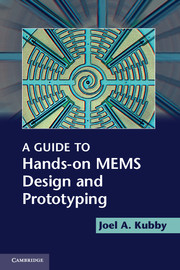6 - Fluidic MEMS
Published online by Cambridge University Press: 07 September 2011
Summary
Fluidic MEMS were some of the earliest and most commercially successful MEMS devices. The inkjet printer has displaced many of the other printing technologies for desktop and photographic color printing and is now penetrating the high-end digital printing market. An emerging market is developing for biological “lab-on-a-chip” and sensor applications. The same technology that enables printing color documents on a desktop may enable implantable medical devices to monitor internal chemical concentrations such as blood sugar levels and precisely and continuously dose drugs such as insulin on an as-needed basis. Before considering these applications we consider fluidics on micrometer length scales, as many of the phenomena we are used to on the macroscopic length scales, where our intuitions are formed, do not apply on the microscopic length scales of microfluidic devices.
Information
- Type
- Chapter
- Information
- A Guide to Hands-on MEMS Design and Prototyping , pp. 118 - 134Publisher: Cambridge University PressPrint publication year: 2011
